NSK Angular Contact Ball Bearing
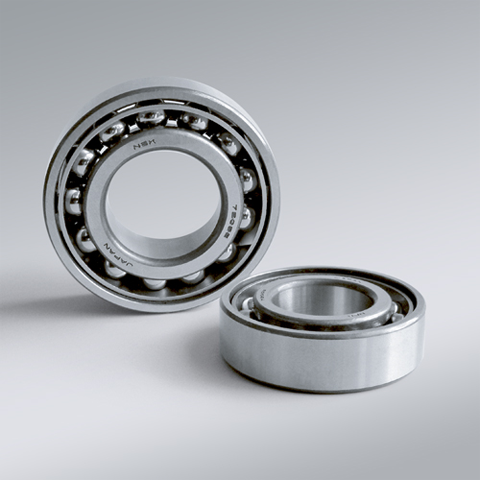
NSK NSK Angular Contact Ball Bearings ,A :Contact Angle of 30°, 7230A ,D=150
NSK Angular Contact Ball Bearings ,A :Contact Angle of 30°, 7230A ,D=150 Bearing Numbers Boundary Dimensions (mm) Basic Load Ratings (kN) Limiting Speeds (min-1) Factor f0 Mass (kg) approx. d D B r min. r1 min. Cr C0r Grease Oil 7230A 150 270 45 3 1.1 248 280 2000 2800 ?€ 11.2 DESIGN, TYPES, AND FEATURES SINGLE-ROW ANGULAR CONTACT BALL BEARINGS Single-row angular contact ball bearings have a contact angle allowing them to sustain significant axial loads in one direction together with radial loads. Because of their design, when a radial load is applied, an axial force component is produced; therefore, two or more opposed bearings must be used. Since the rigidity of single-row angular contact ball bearings can be increased by preloading, they are often used in the main spindles of machine tools where high running accuracy is required (refer to Chapter 9 Preload on Page A192 for more information). Usually, the cages for angular contact ball bearings with a contact angle of 30° (designation A) or 40°(designation B) are made in accordance with Table 1, but depending on the application, machined synthetic-resin cages or molded polyamide-resin cages may also be used. The basic load ratings given in the bearing tables are based on standard cages. Though the figures in the bearing tables on Pages C086 to C101 for bearing bore diameters of 10 to 120 show bearings with single-shoulder inner rings, dual-shoulder bearings are also available. Please consult NSK for more detailed information. MATCHED ANGULAR CONTACT BALL BEARINGS The types and features of matched angular contact ball bearings are shown in Table 2. Table 2 Types and Features of Matched Angular Contact Ball Bearings Figure Arrangement Features Back-to-Back(DB)(Example)7208 A DB Radial loads and axial loads in both directions can be sustained. Since the distance between the effective load centers a0 is large, this type is suitable if moments are applied. Face-to-Face(DF)(Example)7208 B DF Radial loads and axial loads in both directions can be sustained. Compared with the DB Type, the distance between the effective load centers is small, so the capacity to sustain moments is inferior. Tandem(DT)(Example)7208 A DT Radial loads and axial loads in one direction can be sustained. Since two bearings share the axial load, this arrangement is used when the load in one direction is heavy. ?¡Formulation of Bearing Designations Single-Row Matched Angular Contact Ball Bearings ? Bearing type 7 : Single-row angular contact ball bearings, matched angular contact ball bearings ?¡Dimension Series 2 : 02 Series, 3 : 03 Series, 9 : 19 Series, 0 : 10 Series ?¢Bore number Less than 03, Bearing bore 00 : 10mm, 01 : 12mm, 02 : 15mm, 03 : 17mmOver 04, Bearing bore Bore number ×5 (mm) ?£Contact angle C : 15°, A5 : 25°, A : 30°, B : 40° ?¤Internal design EA : High Load Capacity ?¥Cage W : Pressed steel Cage, T85 : Machined brass cage (ball-guided),No designation : Machined brass cage (inner ring guided), TYN : Polyamide resin cage,T85 : Polyamide 46 resin cage, T7 : L-PPS resin cage ?¦Arrangement SU: Universal arrangement (single-row), DU : Universal arrangement (double-row),DB : Back-to-back arrangement, DF : Face-to-face arrangement, DT : Tandem arrangement ?§Preload / Axial internal clearance EL : Extra light preload, L : Light preload, M : Medium preload, H : Heavy preloadOmitted : CN clearance, C3 : Clearance greater than CN, C4 : Clearance greater than C3,CNB : CN Clearance equivalent (universal arrangement) DOUBLE-ROW ANGULAR CONTACT BALL BEARINGS Double-row angular contact ball bearings are essentially a back- to-back mounting of two single-row angular contact ball bearings, but their inner and outer rings are each integrated into one. These bearings can sustain axial loads in both directions and offer good capacity for sustaining moment loads. They are often used as fixed- end bearings and contain cages made of pressed steel. ?¡Formulation of Bearing Designations Double-Row Angular Contact Ball Bearings ? Bearing type 5 : Double-row angular contact ball bearings ?¡Dimension Series 2 : 02 Series 3: 03 Series ?¢Bore number 03 and under: 00 : 10mm, 01 : 12mm, 02 : 15mm, 03 : 17mm 04 and over: Bore diameter bore number ×5 (mm) ?£Internal design ZZ: Steel shield on both sides, DDU: Rubber contact seal on both sides VV: Rubber noncontact seal on both sides ?¤Seals/shields Z: Steel shield on one sides, DU: Rubber contact seal on one side, V: Rubber non-contact seal on one side ?¥Grease* NS7: NS HI-LUBE
$1,880.24
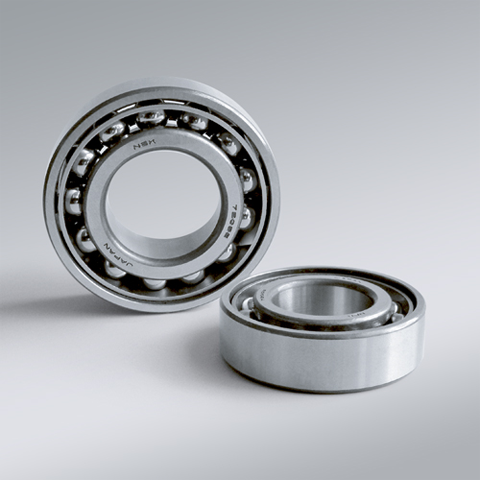
NSK NSK Angular Contact Ball Bearings ,A :Contact Angle of 30°, 7228A ,D=140
NSK Angular Contact Ball Bearings ,A :Contact Angle of 30°, 7228A ,D=140 Bearing Numbers Boundary Dimensions (mm) Basic Load Ratings (kN) Limiting Speeds (min-1) Factor f0 Mass (kg) approx. d D B r min. r1 min. Cr C0r Grease Oil 7228A 140 250 42 3 1.1 218 234 2200 3000 ?€ 8.92 DESIGN, TYPES, AND FEATURES SINGLE-ROW ANGULAR CONTACT BALL BEARINGS Single-row angular contact ball bearings have a contact angle allowing them to sustain significant axial loads in one direction together with radial loads. Because of their design, when a radial load is applied, an axial force component is produced; therefore, two or more opposed bearings must be used. Since the rigidity of single-row angular contact ball bearings can be increased by preloading, they are often used in the main spindles of machine tools where high running accuracy is required (refer to Chapter 9 Preload on Page A192 for more information). Usually, the cages for angular contact ball bearings with a contact angle of 30° (designation A) or 40°(designation B) are made in accordance with Table 1, but depending on the application, machined synthetic-resin cages or molded polyamide-resin cages may also be used. The basic load ratings given in the bearing tables are based on standard cages. Though the figures in the bearing tables on Pages C086 to C101 for bearing bore diameters of 10 to 120 show bearings with single-shoulder inner rings, dual-shoulder bearings are also available. Please consult NSK for more detailed information. MATCHED ANGULAR CONTACT BALL BEARINGS The types and features of matched angular contact ball bearings are shown in Table 2. Table 2 Types and Features of Matched Angular Contact Ball Bearings Figure Arrangement Features Back-to-Back(DB)(Example)7208 A DB Radial loads and axial loads in both directions can be sustained. Since the distance between the effective load centers a0 is large, this type is suitable if moments are applied. Face-to-Face(DF)(Example)7208 B DF Radial loads and axial loads in both directions can be sustained. Compared with the DB Type, the distance between the effective load centers is small, so the capacity to sustain moments is inferior. Tandem(DT)(Example)7208 A DT Radial loads and axial loads in one direction can be sustained. Since two bearings share the axial load, this arrangement is used when the load in one direction is heavy. ?¡Formulation of Bearing Designations Single-Row Matched Angular Contact Ball Bearings ? Bearing type 7 : Single-row angular contact ball bearings, matched angular contact ball bearings ?¡Dimension Series 2 : 02 Series, 3 : 03 Series, 9 : 19 Series, 0 : 10 Series ?¢Bore number Less than 03, Bearing bore 00 : 10mm, 01 : 12mm, 02 : 15mm, 03 : 17mmOver 04, Bearing bore Bore number ×5 (mm) ?£Contact angle C : 15°, A5 : 25°, A : 30°, B : 40° ?¤Internal design EA : High Load Capacity ?¥Cage W : Pressed steel Cage, T85 : Machined brass cage (ball-guided),No designation : Machined brass cage (inner ring guided), TYN : Polyamide resin cage,T85 : Polyamide 46 resin cage, T7 : L-PPS resin cage ?¦Arrangement SU: Universal arrangement (single-row), DU : Universal arrangement (double-row),DB : Back-to-back arrangement, DF : Face-to-face arrangement, DT : Tandem arrangement ?§Preload / Axial internal clearance EL : Extra light preload, L : Light preload, M : Medium preload, H : Heavy preloadOmitted : CN clearance, C3 : Clearance greater than CN, C4 : Clearance greater than C3,CNB : CN Clearance equivalent (universal arrangement) DOUBLE-ROW ANGULAR CONTACT BALL BEARINGS Double-row angular contact ball bearings are essentially a back- to-back mounting of two single-row angular contact ball bearings, but their inner and outer rings are each integrated into one. These bearings can sustain axial loads in both directions and offer good capacity for sustaining moment loads. They are often used as fixed- end bearings and contain cages made of pressed steel. ?¡Formulation of Bearing Designations Double-Row Angular Contact Ball Bearings ? Bearing type 5 : Double-row angular contact ball bearings ?¡Dimension Series 2 : 02 Series 3: 03 Series ?¢Bore number 03 and under: 00 : 10mm, 01 : 12mm, 02 : 15mm, 03 : 17mm 04 and over: Bore diameter bore number ×5 (mm) ?£Internal design ZZ: Steel shield on both sides, DDU: Rubber contact seal on both sides VV: Rubber noncontact seal on both sides ?¤Seals/shields Z: Steel shield on one sides, DU: Rubber contact seal on one side, V: Rubber non-contact seal on one side ?¥Grease* NS7: NS HI-LUBE
$1,304.10
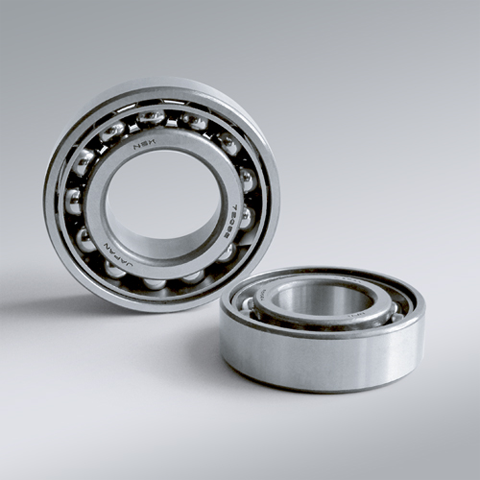
NSK NSK Angular Contact Ball Bearings ,A :Contact Angle of 30°, 7226A ,D=130
NSK Angular Contact Ball Bearings ,A :Contact Angle of 30°, 7226A ,D=130 Bearing Numbers Boundary Dimensions (mm) Basic Load Ratings (kN) Limiting Speeds (min-1) Factor f0 Mass (kg) approx. d D B r min. r1 min. Cr C0r Grease Oil 7226A 130 230 40 3 1.1 189 193 2400 3200 ?€ 7.06 DESIGN, TYPES, AND FEATURES SINGLE-ROW ANGULAR CONTACT BALL BEARINGS Single-row angular contact ball bearings have a contact angle allowing them to sustain significant axial loads in one direction together with radial loads. Because of their design, when a radial load is applied, an axial force component is produced; therefore, two or more opposed bearings must be used. Since the rigidity of single-row angular contact ball bearings can be increased by preloading, they are often used in the main spindles of machine tools where high running accuracy is required (refer to Chapter 9 Preload on Page A192 for more information). Usually, the cages for angular contact ball bearings with a contact angle of 30° (designation A) or 40°(designation B) are made in accordance with Table 1, but depending on the application, machined synthetic-resin cages or molded polyamide-resin cages may also be used. The basic load ratings given in the bearing tables are based on standard cages. Though the figures in the bearing tables on Pages C086 to C101 for bearing bore diameters of 10 to 120 show bearings with single-shoulder inner rings, dual-shoulder bearings are also available. Please consult NSK for more detailed information. MATCHED ANGULAR CONTACT BALL BEARINGS The types and features of matched angular contact ball bearings are shown in Table 2. Table 2 Types and Features of Matched Angular Contact Ball Bearings Figure Arrangement Features Back-to-Back(DB)(Example)7208 A DB Radial loads and axial loads in both directions can be sustained. Since the distance between the effective load centers a0 is large, this type is suitable if moments are applied. Face-to-Face(DF)(Example)7208 B DF Radial loads and axial loads in both directions can be sustained. Compared with the DB Type, the distance between the effective load centers is small, so the capacity to sustain moments is inferior. Tandem(DT)(Example)7208 A DT Radial loads and axial loads in one direction can be sustained. Since two bearings share the axial load, this arrangement is used when the load in one direction is heavy. ?¡Formulation of Bearing Designations Single-Row Matched Angular Contact Ball Bearings ? Bearing type 7 : Single-row angular contact ball bearings, matched angular contact ball bearings ?¡Dimension Series 2 : 02 Series, 3 : 03 Series, 9 : 19 Series, 0 : 10 Series ?¢Bore number Less than 03, Bearing bore 00 : 10mm, 01 : 12mm, 02 : 15mm, 03 : 17mmOver 04, Bearing bore Bore number ×5 (mm) ?£Contact angle C : 15°, A5 : 25°, A : 30°, B : 40° ?¤Internal design EA : High Load Capacity ?¥Cage W : Pressed steel Cage, T85 : Machined brass cage (ball-guided),No designation : Machined brass cage (inner ring guided), TYN : Polyamide resin cage,T85 : Polyamide 46 resin cage, T7 : L-PPS resin cage ?¦Arrangement SU: Universal arrangement (single-row), DU : Universal arrangement (double-row),DB : Back-to-back arrangement, DF : Face-to-face arrangement, DT : Tandem arrangement ?§Preload / Axial internal clearance EL : Extra light preload, L : Light preload, M : Medium preload, H : Heavy preloadOmitted : CN clearance, C3 : Clearance greater than CN, C4 : Clearance greater than C3,CNB : CN Clearance equivalent (universal arrangement) DOUBLE-ROW ANGULAR CONTACT BALL BEARINGS Double-row angular contact ball bearings are essentially a back- to-back mounting of two single-row angular contact ball bearings, but their inner and outer rings are each integrated into one. These bearings can sustain axial loads in both directions and offer good capacity for sustaining moment loads. They are often used as fixed- end bearings and contain cages made of pressed steel. ?¡Formulation of Bearing Designations Double-Row Angular Contact Ball Bearings ? Bearing type 5 : Double-row angular contact ball bearings ?¡Dimension Series 2 : 02 Series 3: 03 Series ?¢Bore number 03 and under: 00 : 10mm, 01 : 12mm, 02 : 15mm, 03 : 17mm 04 and over: Bore diameter bore number ×5 (mm) ?£Internal design ZZ: Steel shield on both sides, DDU: Rubber contact seal on both sides VV: Rubber noncontact seal on both sides ?¤Seals/shields Z: Steel shield on one sides, DU: Rubber contact seal on one side, V: Rubber non-contact seal on one side ?¥Grease* NS7: NS HI-LUBE
$1,181.36
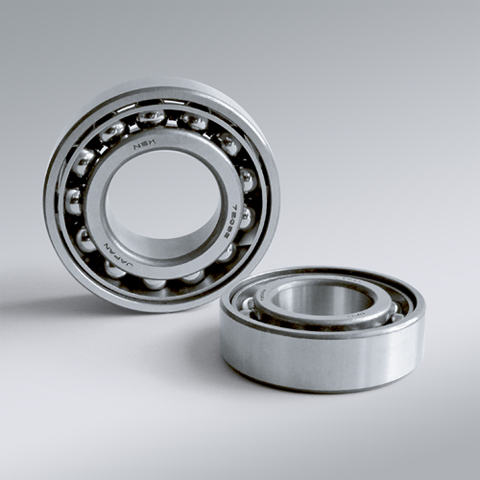
NSK NSK Angular Contact Ball Bearings ,A :Contact Angle of 30°, 7224A ,D=120
NSK Angular Contact Ball Bearings ,A :Contact Angle of 30°, 7224A ,D=120 Bearing Numbers Boundary Dimensions (mm) Basic Load Ratings (kN) Limiting Speeds (min-1) Factor f0 Mass (kg) approx. d D B r min. r1 min. Cr C0r Grease Oil 7224A 120 215 40 2.1 1.1 183 177 3200 4500 ?€ 6.22 DESIGN, TYPES, AND FEATURES SINGLE-ROW ANGULAR CONTACT BALL BEARINGS Single-row angular contact ball bearings have a contact angle allowing them to sustain significant axial loads in one direction together with radial loads. Because of their design, when a radial load is applied, an axial force component is produced; therefore, two or more opposed bearings must be used. Since the rigidity of single-row angular contact ball bearings can be increased by preloading, they are often used in the main spindles of machine tools where high running accuracy is required (refer to Chapter 9 Preload on Page A192 for more information). Usually, the cages for angular contact ball bearings with a contact angle of 30° (designation A) or 40°(designation B) are made in accordance with Table 1, but depending on the application, machined synthetic-resin cages or molded polyamide-resin cages may also be used. The basic load ratings given in the bearing tables are based on standard cages. Though the figures in the bearing tables on Pages C086 to C101 for bearing bore diameters of 10 to 120 show bearings with single-shoulder inner rings, dual-shoulder bearings are also available. Please consult NSK for more detailed information. MATCHED ANGULAR CONTACT BALL BEARINGS The types and features of matched angular contact ball bearings are shown in Table 2. Table 2 Types and Features of Matched Angular Contact Ball Bearings Figure Arrangement Features Back-to-Back(DB)(Example)7208 A DB Radial loads and axial loads in both directions can be sustained. Since the distance between the effective load centers a0 is large, this type is suitable if moments are applied. Face-to-Face(DF)(Example)7208 B DF Radial loads and axial loads in both directions can be sustained. Compared with the DB Type, the distance between the effective load centers is small, so the capacity to sustain moments is inferior. Tandem(DT)(Example)7208 A DT Radial loads and axial loads in one direction can be sustained. Since two bearings share the axial load, this arrangement is used when the load in one direction is heavy. ?¡Formulation of Bearing Designations Single-Row Matched Angular Contact Ball Bearings ? Bearing type 7 : Single-row angular contact ball bearings, matched angular contact ball bearings ?¡Dimension Series 2 : 02 Series, 3 : 03 Series, 9 : 19 Series, 0 : 10 Series ?¢Bore number Less than 03, Bearing bore 00 : 10mm, 01 : 12mm, 02 : 15mm, 03 : 17mmOver 04, Bearing bore Bore number ×5 (mm) ?£Contact angle C : 15°, A5 : 25°, A : 30°, B : 40° ?¤Internal design EA : High Load Capacity ?¥Cage W : Pressed steel Cage, T85 : Machined brass cage (ball-guided),No designation : Machined brass cage (inner ring guided), TYN : Polyamide resin cage,T85 : Polyamide 46 resin cage, T7 : L-PPS resin cage ?¦Arrangement SU: Universal arrangement (single-row), DU : Universal arrangement (double-row),DB : Back-to-back arrangement, DF : Face-to-face arrangement, DT : Tandem arrangement ?§Preload / Axial internal clearance EL : Extra light preload, L : Light preload, M : Medium preload, H : Heavy preloadOmitted : CN clearance, C3 : Clearance greater than CN, C4 : Clearance greater than C3,CNB : CN Clearance equivalent (universal arrangement) DOUBLE-ROW ANGULAR CONTACT BALL BEARINGS Double-row angular contact ball bearings are essentially a back- to-back mounting of two single-row angular contact ball bearings, but their inner and outer rings are each integrated into one. These bearings can sustain axial loads in both directions and offer good capacity for sustaining moment loads. They are often used as fixed- end bearings and contain cages made of pressed steel. ?¡Formulation of Bearing Designations Double-Row Angular Contact Ball Bearings ? Bearing type 5 : Double-row angular contact ball bearings ?¡Dimension Series 2 : 02 Series 3: 03 Series ?¢Bore number 03 and under: 00 : 10mm, 01 : 12mm, 02 : 15mm, 03 : 17mm 04 and over: Bore diameter bore number ×5 (mm) ?£Internal design ZZ: Steel shield on both sides, DDU: Rubber contact seal on both sides VV: Rubber noncontact seal on both sides ?¤Seals/shields Z: Steel shield on one sides, DU: Rubber contact seal on one side, V: Rubber non-contact seal on one side ?¥Grease* NS7: NS HI-LUBE
$938.84

NSK NSK Angular Contact Ball Bearings ,A :Contact Angle of 30°, 7222A ,D=110
NSK Angular Contact Ball Bearings ,A :Contact Angle of 30°, 7222A ,D=110 Bearing Numbers Boundary Dimensions (mm) Basic Load Ratings (kN) Limiting Speeds (min-1) Factor f0 Mass (kg) approx. d D B r min. r1 min. Cr C0r Grease Oil 7222A 110 200 38 2.1 1.1 170 158 2800 3800 ?€ 4.49 DESIGN, TYPES, AND FEATURES SINGLE-ROW ANGULAR CONTACT BALL BEARINGS Single-row angular contact ball bearings have a contact angle allowing them to sustain significant axial loads in one direction together with radial loads. Because of their design, when a radial load is applied, an axial force component is produced; therefore, two or more opposed bearings must be used. Since the rigidity of single-row angular contact ball bearings can be increased by preloading, they are often used in the main spindles of machine tools where high running accuracy is required (refer to Chapter 9 Preload on Page A192 for more information). Usually, the cages for angular contact ball bearings with a contact angle of 30° (designation A) or 40°(designation B) are made in accordance with Table 1, but depending on the application, machined synthetic-resin cages or molded polyamide-resin cages may also be used. The basic load ratings given in the bearing tables are based on standard cages. Though the figures in the bearing tables on Pages C086 to C101 for bearing bore diameters of 10 to 120 show bearings with single-shoulder inner rings, dual-shoulder bearings are also available. Please consult NSK for more detailed information. MATCHED ANGULAR CONTACT BALL BEARINGS The types and features of matched angular contact ball bearings are shown in Table 2. Table 2 Types and Features of Matched Angular Contact Ball Bearings Figure Arrangement Features Back-to-Back(DB)(Example)7208 A DB Radial loads and axial loads in both directions can be sustained. Since the distance between the effective load centers a0 is large, this type is suitable if moments are applied. Face-to-Face(DF)(Example)7208 B DF Radial loads and axial loads in both directions can be sustained. Compared with the DB Type, the distance between the effective load centers is small, so the capacity to sustain moments is inferior. Tandem(DT)(Example)7208 A DT Radial loads and axial loads in one direction can be sustained. Since two bearings share the axial load, this arrangement is used when the load in one direction is heavy. ?¡Formulation of Bearing Designations Single-Row Matched Angular Contact Ball Bearings ? Bearing type 7 : Single-row angular contact ball bearings, matched angular contact ball bearings ?¡Dimension Series 2 : 02 Series, 3 : 03 Series, 9 : 19 Series, 0 : 10 Series ?¢Bore number Less than 03, Bearing bore 00 : 10mm, 01 : 12mm, 02 : 15mm, 03 : 17mmOver 04, Bearing bore Bore number ×5 (mm) ?£Contact angle C : 15°, A5 : 25°, A : 30°, B : 40° ?¤Internal design EA : High Load Capacity ?¥Cage W : Pressed steel Cage, T85 : Machined brass cage (ball-guided),No designation : Machined brass cage (inner ring guided), TYN : Polyamide resin cage,T85 : Polyamide 46 resin cage, T7 : L-PPS resin cage ?¦Arrangement SU: Universal arrangement (single-row), DU : Universal arrangement (double-row),DB : Back-to-back arrangement, DF : Face-to-face arrangement, DT : Tandem arrangement ?§Preload / Axial internal clearance EL : Extra light preload, L : Light preload, M : Medium preload, H : Heavy preloadOmitted : CN clearance, C3 : Clearance greater than CN, C4 : Clearance greater than C3,CNB : CN Clearance equivalent (universal arrangement) DOUBLE-ROW ANGULAR CONTACT BALL BEARINGS Double-row angular contact ball bearings are essentially a back- to-back mounting of two single-row angular contact ball bearings, but their inner and outer rings are each integrated into one. These bearings can sustain axial loads in both directions and offer good capacity for sustaining moment loads. They are often used as fixed- end bearings and contain cages made of pressed steel. ?¡Formulation of Bearing Designations Double-Row Angular Contact Ball Bearings ? Bearing type 5 : Double-row angular contact ball bearings ?¡Dimension Series 2 : 02 Series 3: 03 Series ?¢Bore number 03 and under: 00 : 10mm, 01 : 12mm, 02 : 15mm, 03 : 17mm 04 and over: Bore diameter bore number ×5 (mm) ?£Internal design ZZ: Steel shield on both sides, DDU: Rubber contact seal on both sides VV: Rubber noncontact seal on both sides ?¤Seals/shields Z: Steel shield on one sides, DU: Rubber contact seal on one side, V: Rubber non-contact seal on one side ?¥Grease* NS7: NS HI-LUBE
$658.80
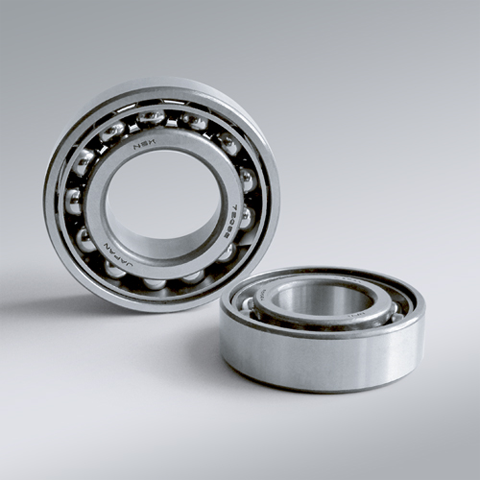
NSK NSK Angular Contact Ball Bearings ,A :Contact Angle of 30°, 7221A ,D=105
NSK Angular Contact Ball Bearings ,A :Contact Angle of 30°, 7221A ,D=105 Bearing Numbers Boundary Dimensions (mm) Basic Load Ratings (kN) Limiting Speeds (min-1) Factor f0 Mass (kg) approx. d D B r min. r1 min. Cr C0r Grease Oil 7221A 105 190 36 2.1 1.1 157 142 3000 4000 ?€ 3.84 DESIGN, TYPES, AND FEATURES SINGLE-ROW ANGULAR CONTACT BALL BEARINGS Single-row angular contact ball bearings have a contact angle allowing them to sustain significant axial loads in one direction together with radial loads. Because of their design, when a radial load is applied, an axial force component is produced; therefore, two or more opposed bearings must be used. Since the rigidity of single-row angular contact ball bearings can be increased by preloading, they are often used in the main spindles of machine tools where high running accuracy is required (refer to Chapter 9 Preload on Page A192 for more information). Usually, the cages for angular contact ball bearings with a contact angle of 30° (designation A) or 40°(designation B) are made in accordance with Table 1, but depending on the application, machined synthetic-resin cages or molded polyamide-resin cages may also be used. The basic load ratings given in the bearing tables are based on standard cages. Though the figures in the bearing tables on Pages C086 to C101 for bearing bore diameters of 10 to 120 show bearings with single-shoulder inner rings, dual-shoulder bearings are also available. Please consult NSK for more detailed information. MATCHED ANGULAR CONTACT BALL BEARINGS The types and features of matched angular contact ball bearings are shown in Table 2. Table 2 Types and Features of Matched Angular Contact Ball Bearings Figure Arrangement Features Back-to-Back(DB)(Example)7208 A DB Radial loads and axial loads in both directions can be sustained. Since the distance between the effective load centers a0 is large, this type is suitable if moments are applied. Face-to-Face(DF)(Example)7208 B DF Radial loads and axial loads in both directions can be sustained. Compared with the DB Type, the distance between the effective load centers is small, so the capacity to sustain moments is inferior. Tandem(DT)(Example)7208 A DT Radial loads and axial loads in one direction can be sustained. Since two bearings share the axial load, this arrangement is used when the load in one direction is heavy. ?¡Formulation of Bearing Designations Single-Row Matched Angular Contact Ball Bearings ? Bearing type 7 : Single-row angular contact ball bearings, matched angular contact ball bearings ?¡Dimension Series 2 : 02 Series, 3 : 03 Series, 9 : 19 Series, 0 : 10 Series ?¢Bore number Less than 03, Bearing bore 00 : 10mm, 01 : 12mm, 02 : 15mm, 03 : 17mmOver 04, Bearing bore Bore number ×5 (mm) ?£Contact angle C : 15°, A5 : 25°, A : 30°, B : 40° ?¤Internal design EA : High Load Capacity ?¥Cage W : Pressed steel Cage, T85 : Machined brass cage (ball-guided),No designation : Machined brass cage (inner ring guided), TYN : Polyamide resin cage,T85 : Polyamide 46 resin cage, T7 : L-PPS resin cage ?¦Arrangement SU: Universal arrangement (single-row), DU : Universal arrangement (double-row),DB : Back-to-back arrangement, DF : Face-to-face arrangement, DT : Tandem arrangement ?§Preload / Axial internal clearance EL : Extra light preload, L : Light preload, M : Medium preload, H : Heavy preloadOmitted : CN clearance, C3 : Clearance greater than CN, C4 : Clearance greater than C3,CNB : CN Clearance equivalent (universal arrangement) DOUBLE-ROW ANGULAR CONTACT BALL BEARINGS Double-row angular contact ball bearings are essentially a back- to-back mounting of two single-row angular contact ball bearings, but their inner and outer rings are each integrated into one. These bearings can sustain axial loads in both directions and offer good capacity for sustaining moment loads. They are often used as fixed- end bearings and contain cages made of pressed steel. ?¡Formulation of Bearing Designations Double-Row Angular Contact Ball Bearings ? Bearing type 5 : Double-row angular contact ball bearings ?¡Dimension Series 2 : 02 Series 3: 03 Series ?¢Bore number 03 and under: 00 : 10mm, 01 : 12mm, 02 : 15mm, 03 : 17mm 04 and over: Bore diameter bore number ×5 (mm) ?£Internal design ZZ: Steel shield on both sides, DDU: Rubber contact seal on both sides VV: Rubber noncontact seal on both sides ?¤Seals/shields Z: Steel shield on one sides, DU: Rubber contact seal on one side, V: Rubber non-contact seal on one side ?¥Grease* NS7: NS HI-LUBE
$560.44
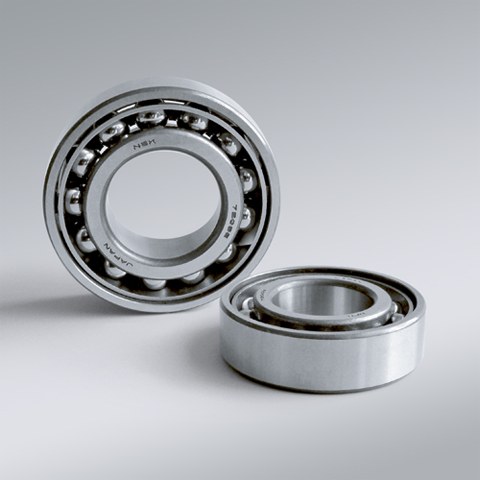
NSK NSK Angular Contact Ball Bearings ,A :Contact Angle of 30°, 7220AW ,D=100
NSK Angular Contact Ball Bearings ,A :Contact Angle of 30°, 7220AW ,D=100 Bearing Numbers Boundary Dimensions (mm) Basic Load Ratings (kN) Limiting Speeds (min-1) Factor f0 Mass (kg) approx. d D B r min. r1 min. Cr C0r Grease Oil 7220AW 100 180 34 2.1 1.1 144 126 3200 4300 ?€ 3.22 DESIGN, TYPES, AND FEATURES SINGLE-ROW ANGULAR CONTACT BALL BEARINGS Single-row angular contact ball bearings have a contact angle allowing them to sustain significant axial loads in one direction together with radial loads. Because of their design, when a radial load is applied, an axial force component is produced; therefore, two or more opposed bearings must be used. Since the rigidity of single-row angular contact ball bearings can be increased by preloading, they are often used in the main spindles of machine tools where high running accuracy is required (refer to Chapter 9 Preload on Page A192 for more information). Usually, the cages for angular contact ball bearings with a contact angle of 30° (designation A) or 40°(designation B) are made in accordance with Table 1, but depending on the application, machined synthetic-resin cages or molded polyamide-resin cages may also be used. The basic load ratings given in the bearing tables are based on standard cages. Though the figures in the bearing tables on Pages C086 to C101 for bearing bore diameters of 10 to 120 show bearings with single-shoulder inner rings, dual-shoulder bearings are also available. Please consult NSK for more detailed information. MATCHED ANGULAR CONTACT BALL BEARINGS The types and features of matched angular contact ball bearings are shown in Table 2. Table 2 Types and Features of Matched Angular Contact Ball Bearings Figure Arrangement Features Back-to-Back(DB)(Example)7208 A DB Radial loads and axial loads in both directions can be sustained. Since the distance between the effective load centers a0 is large, this type is suitable if moments are applied. Face-to-Face(DF)(Example)7208 B DF Radial loads and axial loads in both directions can be sustained. Compared with the DB Type, the distance between the effective load centers is small, so the capacity to sustain moments is inferior. Tandem(DT)(Example)7208 A DT Radial loads and axial loads in one direction can be sustained. Since two bearings share the axial load, this arrangement is used when the load in one direction is heavy. ?¡Formulation of Bearing Designations Single-Row Matched Angular Contact Ball Bearings ? Bearing type 7 : Single-row angular contact ball bearings, matched angular contact ball bearings ?¡Dimension Series 2 : 02 Series, 3 : 03 Series, 9 : 19 Series, 0 : 10 Series ?¢Bore number Less than 03, Bearing bore 00 : 10mm, 01 : 12mm, 02 : 15mm, 03 : 17mmOver 04, Bearing bore Bore number ×5 (mm) ?£Contact angle C : 15°, A5 : 25°, A : 30°, B : 40° ?¤Internal design EA : High Load Capacity ?¥Cage W : Pressed steel Cage, T85 : Machined brass cage (ball-guided),No designation : Machined brass cage (inner ring guided), TYN : Polyamide resin cage,T85 : Polyamide 46 resin cage, T7 : L-PPS resin cage ?¦Arrangement SU: Universal arrangement (single-row), DU : Universal arrangement (double-row),DB : Back-to-back arrangement, DF : Face-to-face arrangement, DT : Tandem arrangement ?§Preload / Axial internal clearance EL : Extra light preload, L : Light preload, M : Medium preload, H : Heavy preloadOmitted : CN clearance, C3 : Clearance greater than CN, C4 : Clearance greater than C3,CNB : CN Clearance equivalent (universal arrangement) DOUBLE-ROW ANGULAR CONTACT BALL BEARINGS Double-row angular contact ball bearings are essentially a back- to-back mounting of two single-row angular contact ball bearings, but their inner and outer rings are each integrated into one. These bearings can sustain axial loads in both directions and offer good capacity for sustaining moment loads. They are often used as fixed- end bearings and contain cages made of pressed steel. ?¡Formulation of Bearing Designations Double-Row Angular Contact Ball Bearings ? Bearing type 5 : Double-row angular contact ball bearings ?¡Dimension Series 2 : 02 Series 3: 03 Series ?¢Bore number 03 and under: 00 : 10mm, 01 : 12mm, 02 : 15mm, 03 : 17mm 04 and over: Bore diameter bore number ×5 (mm) ?£Internal design ZZ: Steel shield on both sides, DDU: Rubber contact seal on both sides VV: Rubber noncontact seal on both sides ?¤Seals/shields Z: Steel shield on one sides, DU: Rubber contact seal on one side, V: Rubber non-contact seal on one side ?¥Grease* NS7: NS HI-LUBE
$294.08
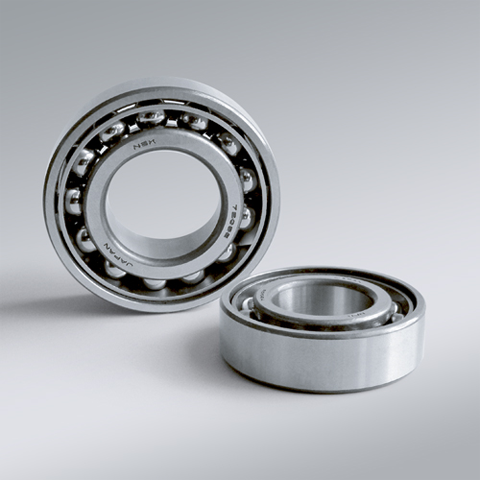
NSK NSK Angular Contact Ball Bearings ,A :Contact Angle of 30°, 7219AW ,D=95
NSK Angular Contact Ball Bearings ,A :Contact Angle of 30°, 7219AW ,D=95 Bearing Numbers Boundary Dimensions (mm) Basic Load Ratings (kN) Limiting Speeds (min-1) Factor f0 Mass (kg) approx. d D B r min. r1 min. Cr C0r Grease Oil 7219AW 95 170 32 2.1 1.1 128 111 3400 4500 ?€ 2.68 DESIGN, TYPES, AND FEATURES SINGLE-ROW ANGULAR CONTACT BALL BEARINGS Single-row angular contact ball bearings have a contact angle allowing them to sustain significant axial loads in one direction together with radial loads. Because of their design, when a radial load is applied, an axial force component is produced; therefore, two or more opposed bearings must be used. Since the rigidity of single-row angular contact ball bearings can be increased by preloading, they are often used in the main spindles of machine tools where high running accuracy is required (refer to Chapter 9 Preload on Page A192 for more information). Usually, the cages for angular contact ball bearings with a contact angle of 30° (designation A) or 40°(designation B) are made in accordance with Table 1, but depending on the application, machined synthetic-resin cages or molded polyamide-resin cages may also be used. The basic load ratings given in the bearing tables are based on standard cages. Though the figures in the bearing tables on Pages C086 to C101 for bearing bore diameters of 10 to 120 show bearings with single-shoulder inner rings, dual-shoulder bearings are also available. Please consult NSK for more detailed information. MATCHED ANGULAR CONTACT BALL BEARINGS The types and features of matched angular contact ball bearings are shown in Table 2. Table 2 Types and Features of Matched Angular Contact Ball Bearings Figure Arrangement Features Back-to-Back(DB)(Example)7208 A DB Radial loads and axial loads in both directions can be sustained. Since the distance between the effective load centers a0 is large, this type is suitable if moments are applied. Face-to-Face(DF)(Example)7208 B DF Radial loads and axial loads in both directions can be sustained. Compared with the DB Type, the distance between the effective load centers is small, so the capacity to sustain moments is inferior. Tandem(DT)(Example)7208 A DT Radial loads and axial loads in one direction can be sustained. Since two bearings share the axial load, this arrangement is used when the load in one direction is heavy. ?¡Formulation of Bearing Designations Single-Row Matched Angular Contact Ball Bearings ? Bearing type 7 : Single-row angular contact ball bearings, matched angular contact ball bearings ?¡Dimension Series 2 : 02 Series, 3 : 03 Series, 9 : 19 Series, 0 : 10 Series ?¢Bore number Less than 03, Bearing bore 00 : 10mm, 01 : 12mm, 02 : 15mm, 03 : 17mmOver 04, Bearing bore Bore number ×5 (mm) ?£Contact angle C : 15°, A5 : 25°, A : 30°, B : 40° ?¤Internal design EA : High Load Capacity ?¥Cage W : Pressed steel Cage, T85 : Machined brass cage (ball-guided),No designation : Machined brass cage (inner ring guided), TYN : Polyamide resin cage,T85 : Polyamide 46 resin cage, T7 : L-PPS resin cage ?¦Arrangement SU: Universal arrangement (single-row), DU : Universal arrangement (double-row),DB : Back-to-back arrangement, DF : Face-to-face arrangement, DT : Tandem arrangement ?§Preload / Axial internal clearance EL : Extra light preload, L : Light preload, M : Medium preload, H : Heavy preloadOmitted : CN clearance, C3 : Clearance greater than CN, C4 : Clearance greater than C3,CNB : CN Clearance equivalent (universal arrangement) DOUBLE-ROW ANGULAR CONTACT BALL BEARINGS Double-row angular contact ball bearings are essentially a back- to-back mounting of two single-row angular contact ball bearings, but their inner and outer rings are each integrated into one. These bearings can sustain axial loads in both directions and offer good capacity for sustaining moment loads. They are often used as fixed- end bearings and contain cages made of pressed steel. ?¡Formulation of Bearing Designations Double-Row Angular Contact Ball Bearings ? Bearing type 5 : Double-row angular contact ball bearings ?¡Dimension Series 2 : 02 Series 3: 03 Series ?¢Bore number 03 and under: 00 : 10mm, 01 : 12mm, 02 : 15mm, 03 : 17mm 04 and over: Bore diameter bore number ×5 (mm) ?£Internal design ZZ: Steel shield on both sides, DDU: Rubber contact seal on both sides VV: Rubber noncontact seal on both sides ?¤Seals/shields Z: Steel shield on one sides, DU: Rubber contact seal on one side, V: Rubber non-contact seal on one side ?¥Grease* NS7: NS HI-LUBE
$255.32
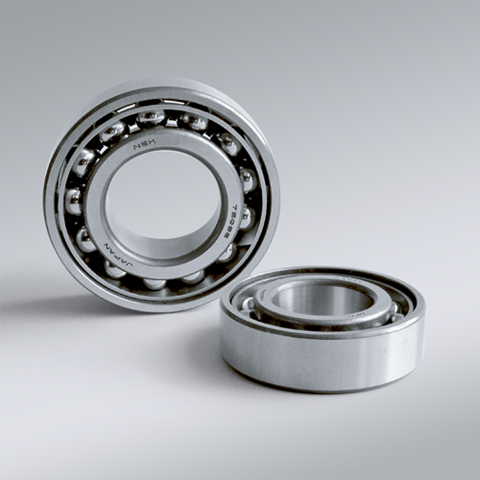
NSK NSK Angular Contact Ball Bearings ,A :Contact Angle of 30°, 7218AW ,D=90
NSK Angular Contact Ball Bearings ,A :Contact Angle of 30°, 7218AW ,D=90 Bearing Numbers Boundary Dimensions (mm) Basic Load Ratings (kN) Limiting Speeds (min-1) Factor f0 Mass (kg) approx. d D B r min. r1 min. Cr C0r Grease Oil 7218AW 90 160 30 2 1 118 103 3600 4800 ?€ 2.25 DESIGN, TYPES, AND FEATURES SINGLE-ROW ANGULAR CONTACT BALL BEARINGS Single-row angular contact ball bearings have a contact angle allowing them to sustain significant axial loads in one direction together with radial loads. Because of their design, when a radial load is applied, an axial force component is produced; therefore, two or more opposed bearings must be used. Since the rigidity of single-row angular contact ball bearings can be increased by preloading, they are often used in the main spindles of machine tools where high running accuracy is required (refer to Chapter 9 Preload on Page A192 for more information). Usually, the cages for angular contact ball bearings with a contact angle of 30° (designation A) or 40°(designation B) are made in accordance with Table 1, but depending on the application, machined synthetic-resin cages or molded polyamide-resin cages may also be used. The basic load ratings given in the bearing tables are based on standard cages. Though the figures in the bearing tables on Pages C086 to C101 for bearing bore diameters of 10 to 120 show bearings with single-shoulder inner rings, dual-shoulder bearings are also available. Please consult NSK for more detailed information. MATCHED ANGULAR CONTACT BALL BEARINGS The types and features of matched angular contact ball bearings are shown in Table 2. Table 2 Types and Features of Matched Angular Contact Ball Bearings Figure Arrangement Features Back-to-Back(DB)(Example)7208 A DB Radial loads and axial loads in both directions can be sustained. Since the distance between the effective load centers a0 is large, this type is suitable if moments are applied. Face-to-Face(DF)(Example)7208 B DF Radial loads and axial loads in both directions can be sustained. Compared with the DB Type, the distance between the effective load centers is small, so the capacity to sustain moments is inferior. Tandem(DT)(Example)7208 A DT Radial loads and axial loads in one direction can be sustained. Since two bearings share the axial load, this arrangement is used when the load in one direction is heavy. ?¡Formulation of Bearing Designations Single-Row Matched Angular Contact Ball Bearings ? Bearing type 7 : Single-row angular contact ball bearings, matched angular contact ball bearings ?¡Dimension Series 2 : 02 Series, 3 : 03 Series, 9 : 19 Series, 0 : 10 Series ?¢Bore number Less than 03, Bearing bore 00 : 10mm, 01 : 12mm, 02 : 15mm, 03 : 17mmOver 04, Bearing bore Bore number ×5 (mm) ?£Contact angle C : 15°, A5 : 25°, A : 30°, B : 40° ?¤Internal design EA : High Load Capacity ?¥Cage W : Pressed steel Cage, T85 : Machined brass cage (ball-guided),No designation : Machined brass cage (inner ring guided), TYN : Polyamide resin cage,T85 : Polyamide 46 resin cage, T7 : L-PPS resin cage ?¦Arrangement SU: Universal arrangement (single-row), DU : Universal arrangement (double-row),DB : Back-to-back arrangement, DF : Face-to-face arrangement, DT : Tandem arrangement ?§Preload / Axial internal clearance EL : Extra light preload, L : Light preload, M : Medium preload, H : Heavy preloadOmitted : CN clearance, C3 : Clearance greater than CN, C4 : Clearance greater than C3,CNB : CN Clearance equivalent (universal arrangement) DOUBLE-ROW ANGULAR CONTACT BALL BEARINGS Double-row angular contact ball bearings are essentially a back- to-back mounting of two single-row angular contact ball bearings, but their inner and outer rings are each integrated into one. These bearings can sustain axial loads in both directions and offer good capacity for sustaining moment loads. They are often used as fixed- end bearings and contain cages made of pressed steel. ?¡Formulation of Bearing Designations Double-Row Angular Contact Ball Bearings ? Bearing type 5 : Double-row angular contact ball bearings ?¡Dimension Series 2 : 02 Series 3: 03 Series ?¢Bore number 03 and under: 00 : 10mm, 01 : 12mm, 02 : 15mm, 03 : 17mm 04 and over: Bore diameter bore number ×5 (mm) ?£Internal design ZZ: Steel shield on both sides, DDU: Rubber contact seal on both sides VV: Rubber noncontact seal on both sides ?¤Seals/shields Z: Steel shield on one sides, DU: Rubber contact seal on one side, V: Rubber non-contact seal on one side ?¥Grease* NS7: NS HI-LUBE
$226.34








